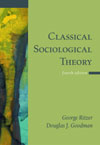
Emile Durkheim |  |
Chapter Outline
II. Social FactsA. Material and Nonmaterial Social Facts B. Types of Nonmaterial Social Facts 1. Morality
2. Collective Conscience
3. Collective Representations
4. Social Currents
C. Group Mind |
III. The Division of Labor in SocietyA. Biographical Sketch B. Mechanical and Organic Solidarity 1. Table: The Four Dimensions of the Collective Conscience
C. Dynamic Density D. Repressive and Restitutive Law E. Normal and Pathological 1. Anomic Division of Labor
2. Forced Division of Labor
F. Justice |
IV. SuicideA. The Four Types of Suicide 1. Egoistic Suicide
2. Altruistic Suicide
3. Anomic Suicide
4. Fatalistic Suicide
5. Table: The Four Types of Suicide
B. Suicide Rates and Social Reform |
V. The Elementary Forms of Religious LifeA. Early and Late Durkheimian Theory B. Theory of Religion-The Sacred and the Profane 1. Beliefs, Rituals, and Church
C. Why Primitive? D. Totemism E. Sociology of Knowledge 1. Categories of Understanding
2. Collective Effervescence
|
VI. Cult of the IndividualA. The Dreyfus Affair, Individualism, and the Intellectuals B. Liberalism versus Communitarianism |
VII. Moral Education and Social ReformA. Morality 1. Discipline
2. Attachment
3. Autonomy
B. Moral Education 1. Occupational Associations
|
VIII. CriticismA. Functionalism and Positivism B. Other Criticisms |
|
|